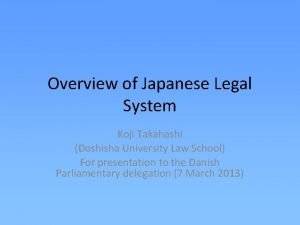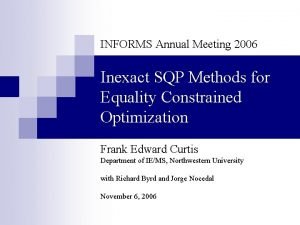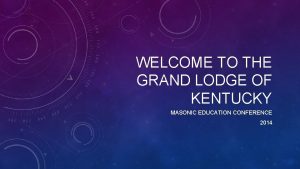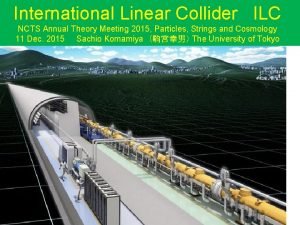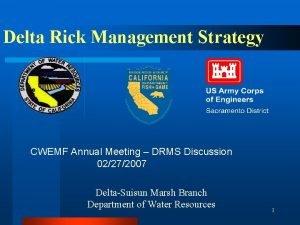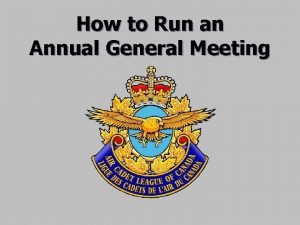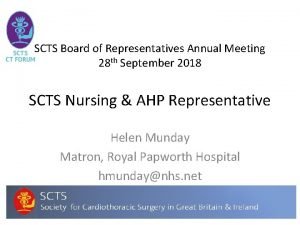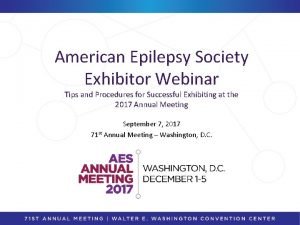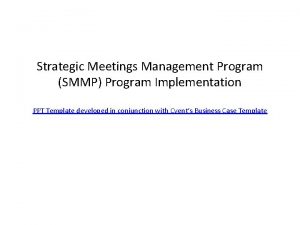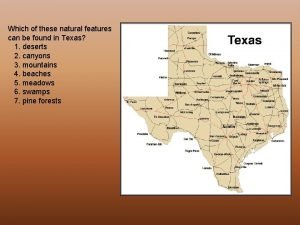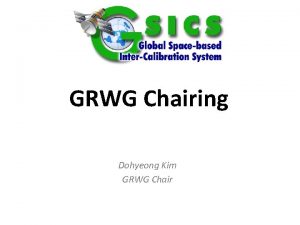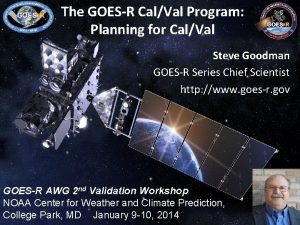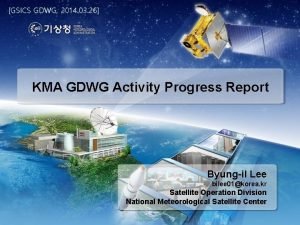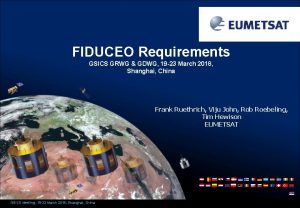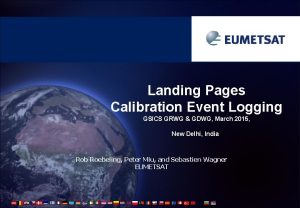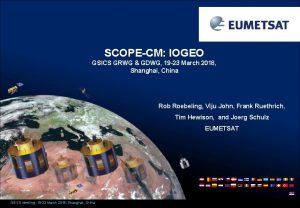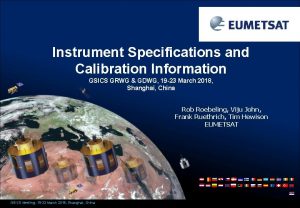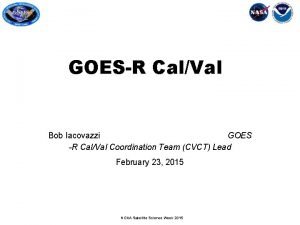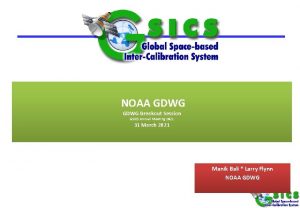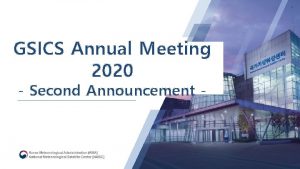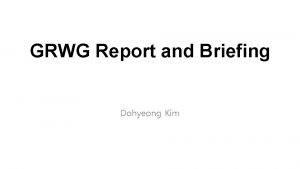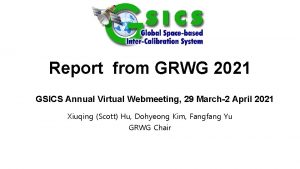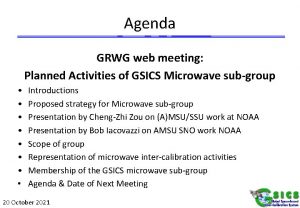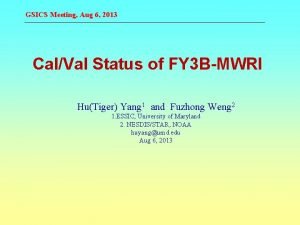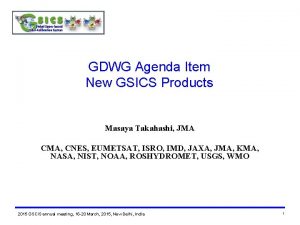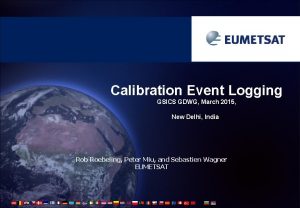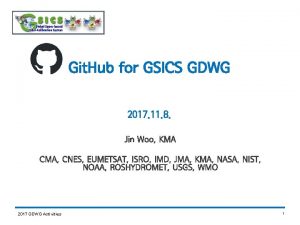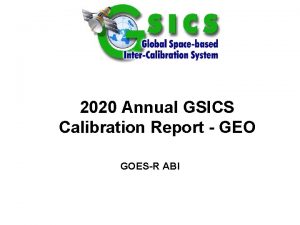GOESR Program CalVal Annual GSICS GRWG GDWG Meeting













![Post-launch Testing -orbit Checkout Calibration input parameter evaluation Radiance [m. W/(m^2 -sr-cm^-1)] KPP product Post-launch Testing -orbit Checkout Calibration input parameter evaluation Radiance [m. W/(m^2 -sr-cm^-1)] KPP product](https://slidetodoc.com/presentation_image_h2/fbb4bbb6dec8c55a41d2dc34926fc4ed/image-14.jpg)





- Slides: 19

GOES-R Program Cal/Val Annual GSICS GRWG & GDWG Meeting March 4, 2013 Bob Iacovazzi, Jr. GOES-R Program Systems Engineering (PSE) Cal/Val Lead

Instrument Overview GOES-R supports NOAA mission to provide forecasts and warnings for the United States, its territories, and adjacent waters for the protection of life and property and the enhancement of the national economy. GOES-R is the next generation of GOES satellites that will provide a major improvement in quality, quantity, and timeliness of data collected. Earth Pointing In-Situ Sun Pointing Spare Visual & IR Imagery • Advanced Baseline Imager (ABI) Lightning Mapping • Geostationary Lightning Mapper (GLM) Space Weather Monitoring • Space Environment in-Situ Sensor Suite (SEISS) • Magnetometer New and improved capabilities for: • • Solar Imaging • Solar Ultra-Violet Imager (SUVI) • Extreme UV/X-Ray Irradiance Sensors (EXIS) increased lead times for severe weather warnings better storm tracking capabilities solar, space weather, and climate analyses advanced products for aviation, transportation, commerce 2

GOES-R Data and Product Overview GOES-R Products L 1 b Solar Imagery: X-ray* Energetic Heavy Ions* Magnetospheric Electrons and Protons: Low Energy* Magnetospheric Electrons and Protons: Medium and High Energy* Solar and Galactic Protons* Geomagnetic Field* Solar Flux: EUV* Cloud and Moisture Imagery (KPP) Rainfall Rate / QPE Legacy Vertical Moisture Profile Legacy Vertical Temperature Profile Derived Stability Indices Total Precipitable Water Clear Sky Masks Downward Shortwave Rad. : Surface Fire / Hot Spot Characterization Land Surface (Skin) Temperature Solar Flux: X-Ray* Lightning Det: Events, Groups, Flashes* Aerosol Detection (including Sea Surface Temperature (skin) Smoke & Dust) Aerosol Optical Depth Reflected Shortwave Rad. : TOA Volcanic Ash: Detection & Height Snow Cover Cloud Optical Depth Derived Motion Winds Cloud Particle Size Distribution Hurricane Intensity Cloud Top Phase Cloud Top Pressure Cloud Top Height Cloud Top Temperature ABI SEISS SUVI GLM EXIS Magnetometer * Included in GRB L 2+ Products are remainder outside of oval Fill Packets Space Wx Mbps Radiances* GOES-R Raw Data Throughput GLM ABI provides 3 x spectral, 4 x coverage, and 5 x temporal resolution of current imager GOES-R product requirements drive instrument performance requirements, which often are the same as, or more strict than, heritage GOES. 3

Importance of Calibration & Validation Calibration: The process to determine factors for converting and correcting raw detector measurements into science data units (e. g. , radiance) with the specified level of accuracy. Calibration is applied to GOES-R raw instrument data to transform them into L 1 b measurements … the fundamental building blocks for all L 2+ products. Validation: The process of determining that the deliverable item satisfies its intended use in its intended environment. Validation provides user confidence that GOES-R data can be used for their intended purpose, e. g. , weather forecasting or numerical weather prediction. GOES-R cal/val requirements are integrated into mission requirements! 4

GOES-R Cal/Val Scope • • • Pre-launch calibration/L 1 B validation o Observe, and validate results of, pre-launch instrument-level calibration tests o Evaluate instrument performance risks and waiver requests o Provide subject matter expert (SME) review of L 1 b algorithm design and implementation o Develop Cal/Val related Post-Launch Test (PLT) planning o Develop tools for post-launch validation and anomaly resolution of L 1 b science data quality Validate expected results from pre-launch system level testing of L 1 b algorithm using synthetic L 0 data Analyze PLT cal/val data results and provide SME support of science data anomaly resolution Coordinate cal/val activities through PLT and Handover Prepare NOAA satellite calibration scientists and engineers for monitoring, analyzing and maintaining GOES-R series instrument calibration and product integrity after Handover GOES-R cal/val enhances understanding of data quality, and encourages “Day-1” operational readiness and long-term user confidence. 5

GOES-R Cal/Val Collaborators Collaborator Main Responsibilities Cal L 1 b Prod Val L 2+ Prod Val Flight Project Oversee SC/Instr. Design, Fabr. , Integ. , and Test SC/Instr Vendors SC/Instr. Design, Fabr. , Integ. , and Test Ground Segment (GS) Project Oversee GS Design, Fabr. , Integ. , and Test GS Vendor GS Design, Fabr. , Integ. , and Test Mission Ops Support Team Gov’t SC/Instr/GS Test Data Ops Support Team Gov’t GS Test Cal Working Group (CWG) PSE Technical Support to GOES-R Instr. Cal & L 1 b Val Algorithm Working Group (AWG) L 2+ Product Dev and V&V NESDIS Office of Satellite and Product Operations (OSPO) Ops Support to Cal/Val All Collaborators participate in the Cal Coordination Team to manage GOES-R cal/val activities. 6

GOES-R Cal/Val Organization GOES-R Program Manager Ground Segment Project (GSP) Manager GSP Prod and Algorithm Lead GSP L 1 b Integ. Project Team GS Vendor GSP Data Ops Support Team (DOST) Program Systems Engineering Lead GOES-R Chief Scientist Instr. /L 1 b Verification L 1 b Science Validation Cal Working Group Cal Coordination Team Cal/Val Technical Cal/Val Management Gov’t GS Tests Algorithm Working Group - L 2+ Product Cal/Val Technical Flight Project (FP) Manager FP Mission Ops Support Team (MOST) Gov’t Satellite Tests FP Instr. Managers Instr. Vendors Cal/Val Collaborators 7

GOES-R Program Cal/Val Documents Calibration and Product Validation Strategy ng orki s, W ie ns & nsibilit o i t a o aniz Resp ules g r e, O oles & ched p o Sc ps, R and S u , Gro urces o Res Cal/Val Plan Vol 2: L 2+ Product Val Cal/Val Plan Vol. 1: L 1 b Data ses nd C al al/V sa d o h t ces Pro Me All documents at CDR-level - Scope defined, technical methods mature, organizational role and responsibilities and processes defined, resources allocated, and schedules defined. 8

GOES-R Cal/Val Resources Pre. Launch Post-Launch Testing Mission Operations Cal/Val, L 0, L 1 b Data Archive/Storage Models/Analysis Tools GOES-R Portal and Web Sites Vendor Offices, Manufacturing Centers, Test Labs/Equipment NIST Test Labs/Equipment NASA Offices & Test Labs/Equipment NOAA Offices Independent Test Facilities (e. g. , Mass General Hospital) Field Campaign Assets (e. g. SURFRAD, ARM) Resource Data and Tools Facilities and Equipment 9

GOES-R Cal/Val Current Status/Updates • Instrument testing support: o Attending instrument Pre-Environmental Review and Pre-ship Review meetings o Cal-related testing activities: ü Observing select ABI, SEISS, and EXIS testing ü Analyzing vendor CDRL 074 test results ü Resolving discrepancies found in CDRL 074 test results with respect to analysis performed by the vendor • • Supporting L 1 b Algorithm and Instrument Cal Data Implementation Preparations for Post-Launch Testing (PLT): o Creating “deep-dive” cal/val analysis tools o Assessing MSFC, NGDC, and STAR agency computing infrastructure needed to support postlaunch GOES-R cal/val o Developing cal-related PLT Short Forms in collaboration with the MOST • Preparations for pre-launch system-level testing and PLT o Developing a GOES-R Cal/Val CONOPS, based on Harris GS design presentations and programlevel cal/val plans o Developing a GOES-R Cal/Val OPSCON that describes processes needed to assess and maintain product integrity o Creating a cal-related PLT implementation tracking spreadsheet, based on GOES-R Cal/Val Plan Volume 1: L 1 b Data 10

Instr Cal and Cal Test Report Review: ABI CWG conducted detailed data analysis on prelaunch tests for proto-type model (PTM) • Reflective and emissive channel calibration • Coherent noise • Irradiance calibration • MTF-Focus-Registration Exelis CWG Emissive (top) and Reflective (bottom) channel calibration test arrangement Coherent noise test results Anomalies caused by not using actual scan mirror reflectance value Government analysis of vendor cal testing reports scrutinizes reproducibility of results and provides valuable feedback to the testing process. Emissive (left) and reflective (right) channel calibration test results ratio of CWG to Exelis cal coefficient 11

Instr Cal and Cal Test Report Review: NIST support for ABI and EXIS • Witness filter characterization (ongoing) • Reflective channel radiance scale validation via visible transfer radiometer (VXR) (planning) 0. 1% contours • FEL-based irradiance scale validation: uniformity test (completed) • Spectral response and irradiance characterization via SIRCUS (completed for PTM) • Characterization of external blackbody via thermal transfer radiometer (TXR) (completed) • EXIS testing at Synchrotron Ultraviolet Radiation Facillity-III (ongoing) Traveling SIRCUS (Spectral Irradiance and Radiance Responsivity Calibration Using Uniform Sources) Spatial uniformity setup NIST testing provides independent validation of instrument performance and in some cases traceability to international standards. Spatial uniformity results at three distances, z. 12

Cal/Val Roadmap to Launch • Continue … Ø Cal testing and test report review and analysis Ø Ensuring proper implementation of L 1 b algorithms, Instrument Cal Data and operational monitoring Ø Creating “deep-dive” cal/val tools Ø Coordinating cal/val efforts between projects and with external operational cal/val support agencies • Cal/Val Related Post-Launch Test (PLT) Preparations Ø PLT detailed test planning will continue with CWG participation • Pre-launch System-level Testing Activities Ø Ø Ensure ability to process data that have been collected during End-to-End Test III Ensure correct cal parameter files are verified and are in place Inspect and analyze data associated with instrument testing Test out functionality of L 1 b “deep-dive” tools 13
![Postlaunch Testing orbit Checkout Calibration input parameter evaluation Radiance m Wm2 srcm1 KPP product Post-launch Testing -orbit Checkout Calibration input parameter evaluation Radiance [m. W/(m^2 -sr-cm^-1)] KPP product](https://slidetodoc.com/presentation_image_h2/fbb4bbb6dec8c55a41d2dc34926fc4ed/image-14.jpg)
Post-launch Testing -orbit Checkout Calibration input parameter evaluation Radiance [m. W/(m^2 -sr-cm^-1)] KPP product quality evaluation On GOES-10 Ch. 4 A Corrected and uncorrected Radiance vs. scan angle. (Beaucom et al. , Proceedings of SPIE, 1999) GOES-13 Hemispheric Image Tiles LEO Hyperspectral Sounder vs. GEO Inter-comparison (Courtesy of Wu et al. ) On-board calibration system evaluation Instrument Noise, Blackbody Temp and Cal Slope Monitoring 14

Post-launch Anomaly Resolution Stray Light GOES-13 Eclipse Season Stray Light Strongly coordinated efforts between Cal Collaborators will be essential to success of postlaunch instrument and L 1 b performance anomaly resolution efforts. GOES-13 Eclipse Season Stray Light Before Fix (Top) and After Fix (Bottom) (Courtesy of J. Paul Douglas, OSPO) 15

Post-Launch Testing Environmental Calibration Initialization Activity near the end of PLT for L 1 b validation and creating a “state-of-the-cal” snapshot for long-term calibration trending Vicarious Calibration Moon ABI Radiometric Cal, MTF and Band-to-band Registration Sonora Desert Stars ABI Radiometric Cal Satellite Inter -Calibration Deep Convective Clouds ABI and GLM Radiometric Cal White Sands Missile Range Desert and Instrumented Sites ABI Radiometric Cal GEO-LEO ABI and GLM Radiometric Cal and INR ARM and SURFRAD GEO-GEO ABI and GLM Radiometric Cal and INR 16

Mission-life sensor parameter and derived product trending Application of ABI Long-term Radiometric Performance tool to GOES-10. (Wu et al. , GSICS Monthly GOES-10 Web Seminar, Dec. 2011, https: //gsics. nesdis. noaa. gov/wiki/ Development/20111213) Application of ABI Co-Registration Validation tool to the GOES Imager. (Grotenhuis, Proc. SPIE 8510, 85101 T 2012. ) Cal activities required during GOES-R acquisition enables long-term monitoring, analysis and maintenance of GOES-R product quality after Handover. Tropical Rainfall Measurement Mission Lightning Imaging Sensor (LIS) Application of GLM Long-term Radiometric Performance tool to LIS (Buechler et al. , Atmos. Res. , 2012) 17

Summary • GOES-R has a comprehensive cal/val program to ensure product integrity Ø Cal/Val Strategy Ø Cal/Val Plans Ø Cal/Val CONOPS&OPSCON • GOES-R leveraging diverse complementary technical capabilities and resources • Provide life cycle cal/val support for a successful GOES-R program 18

GOES-R Pre-Launch Milestones 2010 ü Flight Segment Instruments Spacecraft Program/ System 2011 2013 üMission PDR Part II üMission ü CDR System Design Review complete S/C PDR complete ü üS/C CDR üS/C SDR complete Delta CDR ü ABI complete ü All instruments have passed CDR üCore GS CDR GS PDR ü Core completed Ground Segment 2012 ü Antenna System PDR completed ü Antenna System CDR ü GS Project PDR complete 2015 Launch Readiness Oct. 2015 ABI Delivery EXIS Delivery GLM Delivery MAG Delivery SEISS Delivery SUVI Delivery RBU/NSOF/WCDAS installation CDR üESPDSCLASS CDR 100 % delivery of baseline ü üproduct algorithms üGS Project CDR Development 2014 Integration and Testing WCDAS complete RBU complete NSOF complete 19
 Gdwg law firm
Gdwg law firm Cnes report
Cnes report Informs annual meeting
Informs annual meeting Aupha annual meeting
Aupha annual meeting American psychiatric association annual meeting 2020
American psychiatric association annual meeting 2020 Grand lodge of ky annual meeting
Grand lodge of ky annual meeting Positron vs proton
Positron vs proton Cwemf annual meeting
Cwemf annual meeting How to run an annual general meeting
How to run an annual general meeting Nrg oncology meeting
Nrg oncology meeting Aashto annual meeting 2015
Aashto annual meeting 2015 Scts membership
Scts membership Nrg oncology meeting 2016
Nrg oncology meeting 2016 American epilepsy society annual meeting 2017
American epilepsy society annual meeting 2017 Today meeting or today's meeting
Today meeting or today's meeting Proposal kickoff meeting agenda
Proposal kickoff meeting agenda What is meeting and types of meeting
What is meeting and types of meeting Types of meeting
Types of meeting Strategic meeting management program
Strategic meeting management program Coastal sand plains texas
Coastal sand plains texas
